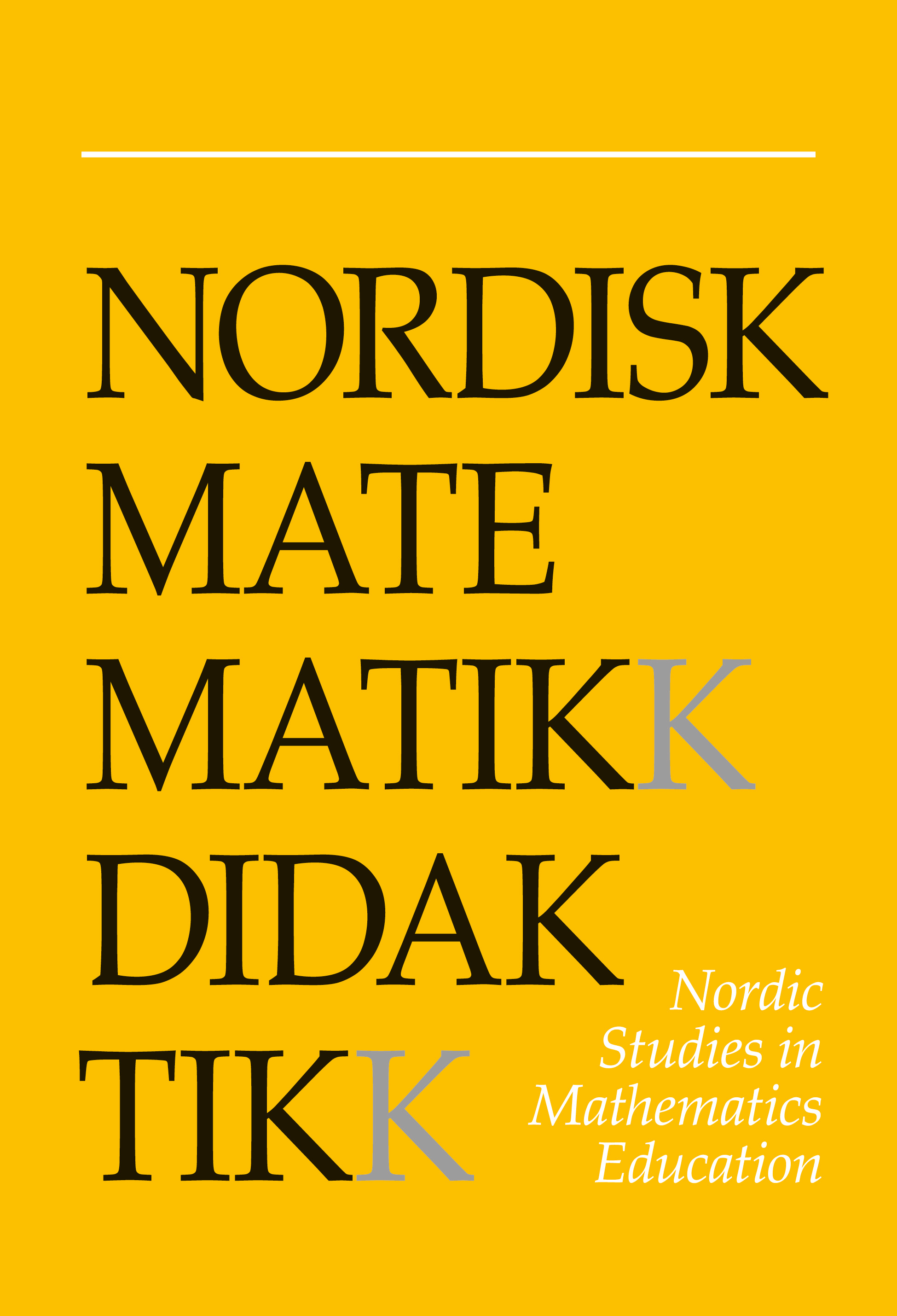En metodisk studie av innholdsanalyse – med analyser av matematikklæreres undervisningskunnskap som eksempel
DOI:
https://doi.org/10.7146/nomad.v20i2.148681Abstract
Innholdsanalyse brukes i hovedsak som begrep i tilknytning til den systematiske prosessen forskere går gjennom når de skal analysere innholdet i et skriftlig datamateriale. Muligheter og begrensninger ved tre ulike tilnærminger til kvalitativ innholdsanalyse diskuteres i artikkelen, med datamateriale fra en studie av læreres undervisningskunnskap i matematikk som eksempel. Konvensjonell innholdsanalyse synes å være velegnet til å få en dybdeforståelse av datamaterialets mening, summativ innholdsanalyse er en noe mer strukturert tilnærming som ved en kombinasjon av manifest og latent analyse kan gi en god oversikt over datamaterialets struktur og innhold, mens teoridreven innholdsanalyse synes å egne seg til å teste hypoteser knyttet til teori.
References
Ball, D. L. & Hill, H. C. (2008). Mathematical knowledge for teaching (MKT) measures [Learning mathematics for teaching project - Mathematics released items 2008]. Lastet ned fra http://sitemaker.umich.edu/lmt/files/LMT_sample_items.pdf
Ball, D. L., Thames, M. H. & Phelps, G. (2008). Content knowledge for teaching: What makes it special? Journal of Teacher Education, 59 (5), 389-407. https://doi.org/10.1177/0022487108324554
Berg, B. L. & Lune, H. (2012). Qualitative research methods for the social sciences (8 utg.). New Jersey: Pearson Education.
Beswick, K. (2011). Knowledge/beliefs and their relationship to emotion. I K. Kislenko (red.), Current state of research on mathematical beliefs XVI: Proceedings of the MAVI-16 conference June 26-29, 2010 (s. 43-59). Institute of Mathematics and Natural Sciences, Tallinn University.
Cavanagh, S. (1997). Content analysis: concepts, methods and applications. Nurse Researcher, 4 (3), 5-16. https://doi.org/10.7748/nr1997.04.4.3.5.c5869
Charmaz, K. (2006). Constructing grounded theory. A practical guide through qualitative analysis. Thousand Oaks: SAGE Publications.
Cohen, L., Manion, L. & Morrison, K. (2007). Research methods in education (6. utg.). London: Routledge. https://doi.org/10.4324/9780203029053
Eraut, M. (2000). Non-formal learning and tacit knowledge in professional work. British Journal of Educational Psychology, 70 (1), 113-136. https://doi.org/10.1348/000709900158001
Ernest, P. (2006). Reflections on theories of learning. ZDM, 38 (1), 3-8. https://doi.org/10.1007/BF02655901
Fauskanger, J. (2013). Teachers' epistemic beliefs about mathematical knowledge for teaching two-digit multiplication. I M. S. Hannula, P. Portaankorva-Koivisto, A. Laine & L. Näveri (red.), Current state of research on mathematical beliefs XVIII: Proceedings of the MAVI-18 conference, September 12-15, 2012 (s. 271-284). University of Helsinki.
Fauskanger, J. & Mosvold, R. (2012). "Wrong, but still right". Teachers reflecting on MKT items. I L. R. Van Zoest, J.-J. Lo & J. L. Kratky (red.), Proceedings of the 34th annual meeting of the North American Chapter of the International Group for the Psychology of Mathematics Education (s. 423-429). Kalamazoo: Western Michigan University.
Fauskanger, J. & Mosvold, R. (2014a). Innholdsanalysens muligheter i utdanningsforskning. Norsk Pedagogisk Tidsskrift, 98 (2), 127-139. https://doi.org/10.18261/ISSN1504-2987-2014-02-07
Fauskanger, J. & Mosvold, R. (2014b). Studying teachers' knowledge by the use of multiple-choice items. The case of "I'm not sure". Nordic Studies in Mathematics Education, 19 (3-4), 41-55.
Fives, H. & Buehl, M. M. (2008). What do teachers believe? Developing a framework for examining beliefs about teachers' knowledge and ability. Contemporary Educational Psychology, 33 (2), 134-176. https://doi.org/10.1016/j.cedpsych.2008.01.001
Hsieh, H.-F. & Shannon, S. E. (2005). Three approaches to qualitative content analysis. Qualitative Health Research, 15 (9), 1277-1288. https://doi.org/10.1177/1049732305276687
Krippendorff, K. (2004). Content analysis: an introduction to its methodology (2. utg.). Thousand Oaks: Sage Publications.
Mayring, P. (2000). Qualitative content analysis. Forum Qualitative Social Research, 1 (2), Art. 20. Lastet ned fra http://www.utsc.utoronto.ca/~kmacd/IDSC10/Readings/text%20analysis/CA.pdf
Mayring, P. (2010). Qualitative Inhaltsanalyse: Grundlagen und Techniken (11. utg.). Weinheim: Beltz Verlag. https://doi.org/10.1007/978-3-531-92052-8_42
Mayring, P. (2014). Qualitative content analysis: theoretical foundation, basic procedures and software solution. Lastet ned fra http://files.qualitative-content-analysis.aau.at/200000075-82241831d6/Mayring(2014)QualitativeContentAnalysis.pdf
Neuendorf, K. A. (2002). The content analysis guidebook. Thousand Oaks: SAGE Publishers.
Nilssen, V. (2012). Analyse i kvalitative studier. Den skrivende forskeren. Oslo: Universitetsforlaget.
Roth, W.-M. (2006). Textbooks on qualitative research and method/ methodology: toward a praxis of method. Forum: Qualitative Social Research, 7 (1), Art. 11. Lastet ned fra http://www.qualitative-research.net/index.php/fqs/ article/download/79/162
Silverman, D. (2013). Doing qualitative research: a practical handbook (4. utg.). London: SAGE publications.
Skemp, R. R. (1976). Relational understanding and instrumental understanding. Mathematics Teaching, 77, 20-26.
Downloads
Published
How to Cite
Issue
Section
License

This work is licensed under a Creative Commons Attribution-NonCommercial-ShareAlike 4.0 International License.



